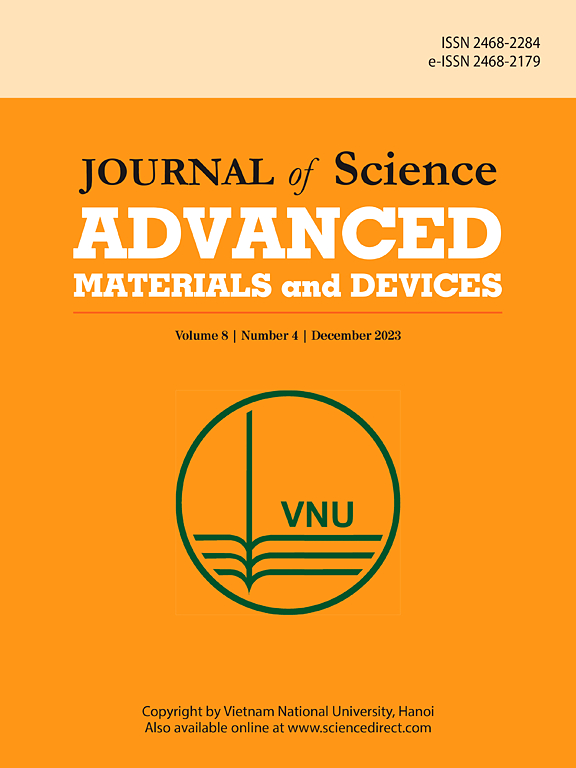Ternary Bi2O3/(BiO)2CO3/g-C3N4 multi-heterojunction nanoflakes for highly efficient photocatalytic degradation of dyes and xanthates under visible light
IF 6.7
3区 材料科学
Q1 MATERIALS SCIENCE, MULTIDISCIPLINARY
Journal of Science: Advanced Materials and Devices
Pub Date : 2024-12-20
DOI:10.1016/j.jsamd.2024.100834
引用次数: 0
Abstract
To enhance the separation efficiency of photogenerated carriers, the formation of photocatalysts with strong interfacial contact heterojunctions is considered an effective approach for the removal of diverse environmental contaminants. In this study, a ternary heterojunction photocatalyst, Bi2O3/(BiO)2CO3/g-C3N4, demonstrated a multifunctional high photocatalytic performance in the degradation of various dyes, including methyl orange (MO), methylene blue (MB), rhodamine B (RB) and xanthates such as potassium ethyl xanthate (PEX), potassium amyl xanthate (PAX) and sodium isopropyl xanthate (SIPX), under visible light irradiation. The Bi₂O₃/(BiO)₂CO₃/g-C₃N₄ photocatalyst was synthesized by heating a mixture of urea and arc discharge synthesized Bi₂O₃-based nanoparticles at 550 °C. This photocatalyst exhibited higher photocatalytic activity compared to Bi2O3/(BiO)2CO3 and g-C3N4. The photocatalysts were characterized and studied by FTIR, XRD, FESEM-EDS elemental mapping, HR-TEM, UV–visible, BET and PL. The formation of an interface between Bi2O3/(BiO)2CO3 and g-C3N4 significantly improved photocatalytic performance by facilitating the effective separation of photogenerated electron-hole pairs. Stability tests of Bi2O3/(BiO)2CO3/g-C3N4 during the degradation of MO demonstrated the photocatalyst's excellent stability and reusability, indicating its potential for practical applications in mineral processing wastewater treatment. Reactive species trapping experiments revealed that holes (h⁺) played the most significant role in photodegradation, followed by hydroxyl radicals (•OH), while superoxide radicals (•O₂⁻) had a lesser impact. Study of two possible photocatalytic mechanisms suggested that the transfer of photogenerated carriers in Bi2O3/(BiO)2CO3/g-C3N4 is more likely to follow a double Z-scheme photocatalytic system. The enhanced photocatalytic performance of Bi2O3/(BiO)2CO3/g-C3N4 can be attributed to considerable specific surface area, stronger visible light absorption and most importantly, well-matched band potentials between Bi₂O₃, (BiO)₂CO₃, and g-C₃N₄. The promising photocatalytic performance of Bi2O3/(BiO)2CO3/g-C3N4, introduces a notable photocatalyst for photodegradation of dyes and xanthates in mineral processing wastewater.
三元Bi2O3/(BiO)2CO3/g-C3N4多异质结纳米片在可见光下高效光催化降解染料和黄药
为了提高光生载体的分离效率,形成具有强界面接触异质结的光催化剂被认为是去除多种环境污染物的有效途径。在本研究中,三元异质结光催化剂Bi2O3/(BiO)2CO3/g-C3N4在可见光照射下,对甲基橙(MO)、亚甲基蓝(MB)、罗丹明B (RB)等多种染料以及乙基黄药钾(PEX)、戊基黄药钾(PAX)和异丙基黄药钠(SIPX)等黄药具有多功能的高催化性能。以尿素和电弧放电合成的Bi₂O₃基纳米颗粒为原料,在550℃下加热,合成了Bi₂O₃/(BiO)₂CO₃/g-C₃N₄光催化剂。与Bi2O3/(BiO)2CO3和g-C3N4相比,该光催化剂具有更高的光催化活性。通过FTIR、XRD、FESEM-EDS元素映射、HR-TEM、UV-visible、BET和PL等手段对所制备的光催化剂进行了表征和研究。结果表明,Bi2O3/(BiO)2CO3与g-C3N4之间形成的界面促进了光生电子-空穴对的有效分离,显著提高了光催化性能。对Bi2O3/(BiO)2CO3/g-C3N4光催化剂在MO降解过程中的稳定性测试表明,该光催化剂具有良好的稳定性和可重复使用性,表明其在选矿废水处理中的实际应用潜力。活性物质捕获实验表明,空穴(h⁺)在光降解中起着最重要的作用,其次是羟基自由基(•OH),而超氧自由基(•O₂⁻)的影响较小。两种可能的光催化机制的研究表明,Bi2O3/(BiO)2CO3/g-C3N4中光生载流子的转移更可能遵循双Z-scheme光催化体系。Bi2O3/(BiO)2CO3/g-C3N4的光催化性能增强可归因于相当大的比表面积、更强的可见光吸收,最重要的是,Bi₂O₃、(BiO)₂CO₃和g-C₃N₄之间的带势匹配良好。Bi2O3/(BiO)2CO3/g-C3N4具有良好的光催化性能,为光降解选矿废水中的染料和黄药提供了一种值得关注的光催化剂。
本文章由计算机程序翻译,如有差异,请以英文原文为准。
求助全文
约1分钟内获得全文
求助全文
来源期刊

Journal of Science: Advanced Materials and Devices
Materials Science-Electronic, Optical and Magnetic Materials
CiteScore
11.90
自引率
2.50%
发文量
88
审稿时长
47 days
期刊介绍:
In 1985, the Journal of Science was founded as a platform for publishing national and international research papers across various disciplines, including natural sciences, technology, social sciences, and humanities. Over the years, the journal has experienced remarkable growth in terms of quality, size, and scope. Today, it encompasses a diverse range of publications dedicated to academic research.
Considering the rapid expansion of materials science, we are pleased to introduce the Journal of Science: Advanced Materials and Devices. This new addition to our journal series offers researchers an exciting opportunity to publish their work on all aspects of materials science and technology within the esteemed Journal of Science.
With this development, we aim to revolutionize the way research in materials science is expressed and organized, further strengthening our commitment to promoting outstanding research across various scientific and technological fields.
 求助内容:
求助内容: 应助结果提醒方式:
应助结果提醒方式:


